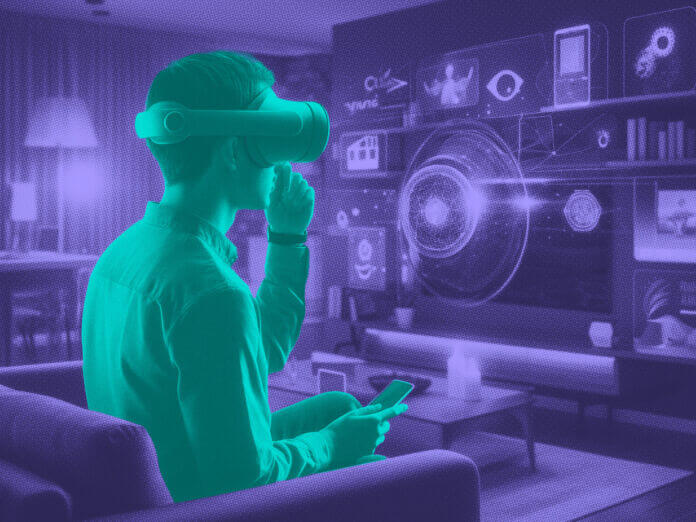
We’re witnessing the exciting evolution of two transformative technologies: Artificial Intelligence and the Metaverse. Metaverse development and its future have become a hot topic among tech professionals. To put it simply, Metaverse is a virtual reality universe allowing users to interact using advanced technologies like AI, augmented reality, and virtual reality.
According to Bloomberg’s report, Metaverse’s market is projected to reach $1303.4 billion by 2030 with a CAGR of 48.0 percent. Needless to say, AI in the Metaverse is playing a big role in innovation and business growth.
In fact, a recent survey by McKinsey revealed that 50 percent of all companies already leverage AI in some form, and a Deloitte study found that 40 percent have enterprise-wide AI strategies. This widespread adoption of AI paves the way for its crucial role in the metaverse’s development with technologies like AI, VR, AR, 5G, and blockchain.
Therefore, the ongoing evolution of AI and the emergence of Metaverse development services herald a promise to redefine human experiences.
Artificial intelligence is the foundational technology upon which the metaverse relies, and it is changing the world with great speed. AI facilitates natural language processing, enabling seamless communication and overcoming language barriers. Furthermore, AI safeguards the Metaverse by detecting and mitigating potential threats to ensure a safe and secure virtual space.
Without AI, the Metaverse would remain a static shell, lacking the intelligence and adaptability that makes it truly transformative. Its ability to learn, adapt, and personalize paves the way for an engaging and boundless virtual future.
That’s why, AI development services for the metaverse are increasingly considered by organizations venturing into this field. Going ahead, let’s find out what AI technologies are used in the metaverse.
The metaverse thrives on the invisible magic of AI technology. Let’s explore how key AI technologies play their part:
Machine learning sits at the heart of the Metaverse, weaving intelligence into its very fabric. It analyzes vast amounts of data from user interactions, environment simulations, and virtual economies, constantly learning and adapting.
Additionally, machine learning allows the metaverse to evolve dynamically, tailoring experiences to individual users, and creating non-player characters (NPCs). This also optimizes performance for smooth and immersive interactions.
The Metaverse envisions a global community where language shouldn’t hinder connection. NLP is the key to unlocking this vision. NLP-powered AI translates speech and text in real-time, enabling seamless communication across languages and cultures.
Moreover, NLP can be used to create personalized experiences for users. To cite an example, NLP-powered AI chatbots can offer customer support services tailored to individual needs.
In the Metaverse, computer vision breathes life by enabling machines to “see” and understand the virtual world. It analyzes visual data from user actions and object interactions and presents a user as an avatar.
Thus, computer vision empowers the Metaverse to react intelligently to your actions, blurring the lines between the virtual and real. Here are some ways in which computer vision creates immersive metaverse environments and objects:
Generative AI plays a game-changing role in creating a realistic-looking world in an immersive environment. Through advanced algorithms, these systems can generate cities, objects, and ecosystems, enhancing the overall user experience.
Moreover, Generative AI allows users to craft interesting stories in the Metaverse. The virtual worlds has the ability to evolve based on user actions, creating an unreal personalized storytelling experience. Whether it’s a video game, social interaction, or educational content, Generative AI adapts based on your choices, or even entire worlds tailored to your specific interests.
Going ahead, let’s throw some light on the AI’s impact on the immersive metaverse experience.
As per the SIEMENS Digital Asset Management Report 2022, the global digital twin market is estimated to reach $125 billion by 2030. This shows how AI algorithms are going to play a big role in populating the vast 3D worlds.
AI can predict preferences based on user data, adjusting sound, haptics, and visuals to create personalized, immersive environments. This could range from generating calming soundscapes when stressed to adjusting the ambient temperature based on your virtual location.
Notable, machine learning leverages multisensory data from the real world to enhance the realism of virtual and mixed-reality experiences. Overall, predictive AI systems are capable of developing responsive environments that react smartly to human actions.
As the metaverse evolves, ethical considerations will surface. With that scenario, AI ensures security, privacy, and safeguards against discrimination, building a safe and inclusive virtual community. This can be achieved with:
Just to mention, Meta and Microsoft have already created AI techniques to identify dangerous information and malicious actors. However, ethical metaverse governance will need attentive AI development to balance freedom, safety, and responsibility in the future.
Metaverse platforms leverage NLP to create lifelike avatars. It further uses AI capabilities for realistic settings, and even captures physical movements, blurring the lines between the physical and digital workspace.
Moreover, virtual workspaces like Spatial and Gather are transforming collaboration. They are allowing teams to interact in immersive meeting rooms, inspect designs together, and even virtually recreate their physical offices.
Lorem ipsum viverra feugiat. Pellen tesque libero ut justo, ultrices in ligula. Semper at. Lorem ipsum dolor sit amet elit. Non quae, fugiat nihil ad. Lorem ipsum dolor sit amet. Lorem ipsum init dolor sit, amet elit. Dolor ipsum non velit, culpa! elit ut et.
Lorem ipsum dolor sit amet elit. Velit beatae rem ullam dolore nisi esse quasi, sit amet. Lorem ipsum dolor sit amet elit.